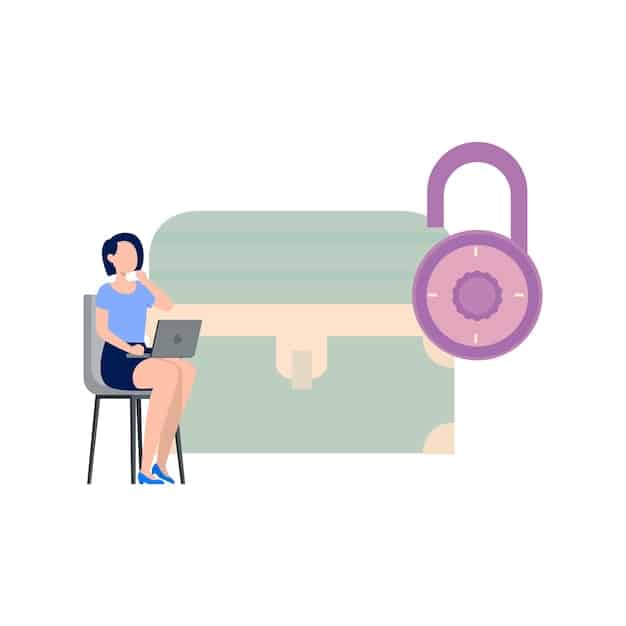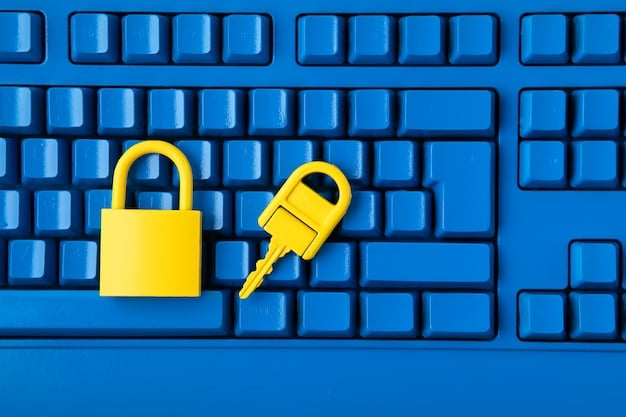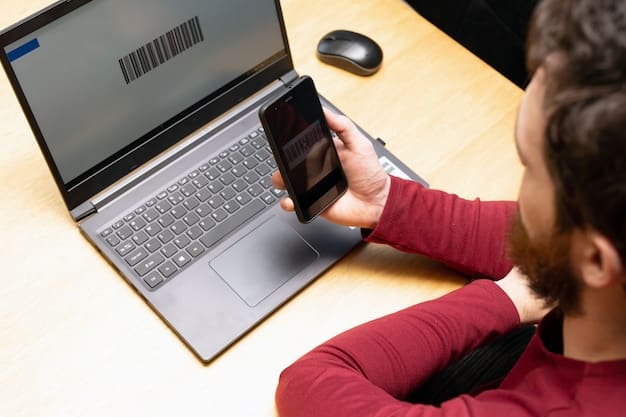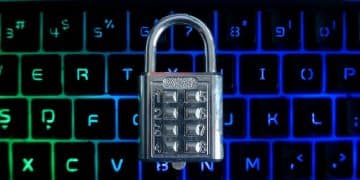Password Security Checklist: 10 Steps to Stronger Online Accounts

A robust password security checklist includes creating strong, unique passwords, enabling multi-factor authentication, using a password manager, regularly updating passwords, avoiding password reuse, securing accounts with recovery options, monitoring for data breaches, being cautious of phishing attempts, educating yourself on password security risks, and implementing password policies.
In today’s digital landscape, password security checklist: 10 steps to stronger online accounts is not just a recommendation; it’s a necessity. Weak or compromised passwords can lead to data breaches, identity theft, and significant financial losses.
Password Security Checklist Introduction
Passwords are the gatekeepers to our digital lives, protecting everything from our email accounts to our financial information. This guide provides a password security checklist: 10 steps to stronger online accounts to help you create and maintain strong passwords, protect your online accounts, and minimize your risk of falling victim to cyber threats.
Why Password Security Matters
In this section, we delve into the importance of password security and the potential consequences of weak passwords. We’ll explore the common threats and vulnerabilities that can compromise your online accounts.
- Data Breaches: Data breaches frequently expose millions of usernames and passwords, which can be exploited by cybercriminals.
- Identity Theft: Weak passwords make it easier for hackers to impersonate you and access sensitive information.
- Financial Loss: Compromising your accounts can lead to unauthorized transactions and financial fraud.
A strong password security strategy is key to mitigating these risks and maintaining a safe online presence. By following the password security checklist: 10 steps to stronger online accounts, you can significantly reduce your vulnerability to cyberattacks.

Step 1: Create Strong, Unique Passwords
The first and most crucial step in any password security checklist: 10 steps to stronger online accounts is creating strong, unique passwords. These passwords should be hard to guess but easy for you to remember.
Let’s explore the factors that contribute to a password’s strength:
Length and Complexity
Longer passwords are generally more secure. Aim for a minimum of 12 characters, and ideally, 16 or more. Include a mix of uppercase and lowercase letters, numbers, and symbols.
Avoid Common Words and Phrases
Do not use dictionary words, names, dates of birth, or other easily guessable information in your passwords. Hackers often use password cracking tools that try common words first.
- Use Passphrases: Consider using a passphrase – a string of several words that are easy to remember but difficult to guess.
- Randomness: The more random your password, the better. Avoid patterns or sequences that can be easily identified.
- Update Regularly: Change your passwords on a regular basis, especially for critical accounts like email and banking.
Creating strong, unique passwords is the foundation of password security checklist: 10 steps to stronger online accounts.
Step 2: Enable Multi-Factor Authentication (MFA)
Multi-factor authentication (MFA) adds an extra layer of security to your accounts, making it harder for unauthorized users to gain access. Regardless of your password security checklist: 10 steps to stronger online accounts, this is essential.
MFA requires you to provide two or more verification factors to confirm your identity:
How MFA Works
MFA typically involves something you know (your password) and something you have (a code sent to your phone or a security key). This means that even if someone manages to steal your password, they still need the second factor to log in.
Types of MFA
There are several types of MFA available, each offering different levels of security and convenience.
- SMS Codes: Receiving a code via text message is a common MFA method, but it’s less secure due to potential interception.
- Authenticator Apps: Apps like Google Authenticator or Authy generate time-based codes that are more secure than SMS codes.
- Hardware Security Keys: Physical keys like YubiKey provide the highest level of security and are resistant to phishing attacks.
By enabling MFA, you add an extra barrier against unauthorized access and significantly enhance your overall security.
Step 3: Use a Password Manager
Managing multiple strong, unique passwords can be challenging, but a password manager can help. A password manager is a tool that securely stores your passwords.
Here’s how a password manager can simplify your password security checklist: 10 steps to stronger online accounts:

Benefits of Password Managers
Password managers generate strong, random passwords for each of your accounts and securely store them in an encrypted vault.
Popular Password Managers
Several reputable password managers are available. Here are a few popular options.
- LastPass: A popular password manager with a user-friendly interface and cross-platform compatibility.
- 1Password: Known for its strong security features and easy-to-use interface.
- Bitwarden: An open-source password manager that offers excellent security and customization options.
Using a password manager ensures that you have strong, unique passwords for all your online accounts without having to remember them all.
Step 4: Regularly Update Your Passwords
Updating your passwords regularly is a crucial step in maintaining strong online security. Think of this as crucial in your password security checklist: 10 steps to stronger online accounts.
Here’s why regular password updates are essential:
Mitigate Breach Risks
If one of your accounts is compromised, regularly changing your passwords limits the damage. By updating your passwords frequently, you minimize the window of opportunity for hackers to exploit stolen credentials.
Set Reminders
Set reminders to change your passwords every three to six months. This ensures that your passwords remain strong and secure over time.
Regular password updates keep your accounts safe from unauthorized access.
Step 5: Avoid Password Reuse
Reusing passwords across multiple accounts is a significant security risk. If one of your passwords is compromised, all accounts using that password become vulnerable. Avoiding password reuse is a critical component of any password security checklist: 10 steps to stronger online accounts.
Why It’s Risky
Password reuse means that if one account is breached, hackers can access all other accounts using the same credentials. This can lead to widespread data breaches and identity theft.
How to Avoid Reuse
- Use a Password Manager: Password managers make it easy to generate and store unique passwords for each account.
- Don’t Rely on Memory: Trying to remember multiple unique passwords is difficult, so use a password manager to manage them securely.
- Regularly Audit Your Accounts: Periodically review your accounts and update any reused passwords.
By avoiding password reuse, you can significantly reduce your risk of falling victim to cyberattacks.
Step 6: Secure Accounts with Recovery Options
Make sure your accounts have secure recovery options set up. This includes a recovery email address and phone number, which can be used to reset your password if you forget it. You can see this as crucial to your password security checklist: 10 steps to stronger online accounts.
Recovery Email
Ensure your recovery email is different from the primary email account you’re trying to protect. This prevents attackers from accessing both accounts simultaneously.
This adds an extra layer of security and makes it easier to regain access to your accounts if they are compromised.
Step 7: Monitor for Data Breaches
Stay informed about data breaches that may affect your accounts. Websites like “Have I Been Pwned?” allow you to check if your email address has been compromised in a known data breach.
How to Check for Breaches
Visit “Have I Been Pwned?” or similar websites and enter your email address to see if it has been involved in a data breach.
What to Do If You’re Breached
If your email address has been compromised, take immediate action to change your passwords on all affected accounts. Enable MFA where possible, and monitor your accounts for any suspicious activity.
Staying vigilant and monitoring for data breaches helps you take proactive steps to protect your accounts.
| Key Point | Brief Description |
|---|---|
| 🔑 Strong Passwords | Create long, complex, and unique passwords for each account. |
| 🛡️ Multi-Factor Authentication | Enable MFA for an extra layer of security using apps or security keys. |
| 🧰 Password Manager | Use a password manager to securely store and generate passwords. |
| 🔄 Regular Updates | Change passwords every three to six months for added security. |
Frequently Asked Questions
▼
Password security is crucial because weak passwords can lead to unauthorized access to your accounts, resulting in identity theft and financial losses.
▼
It is recommended to update your passwords every three to six months, or immediately after a known data breach affecting your accounts.
▼
MFA adds an extra layer of security by requiring two or more verification factors, making it harder for unauthorized users to access your accounts, even with a compromised password.
▼
Yes, reputable password managers use strong encryption to securely store your passwords, making them a safe and convenient way to manage multiple accounts.
▼
If you suspect your password has been compromised, immediately change it, enable MFA if available, and monitor your accounts for any suspicious activity.
Conclusion
In conclusion, prioritizing your **password security checklist: 10 steps to stronger online accounts** is paramount in protecting your digital identity and sensitive information. By implementing these steps, you can significantly reduce your vulnerability to cyber threats and enjoy a safer online experience.





